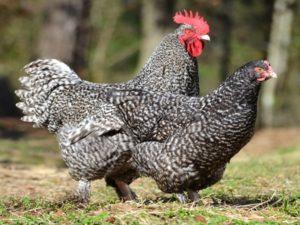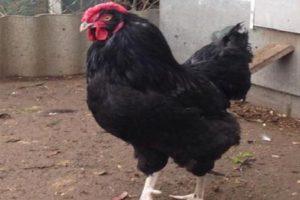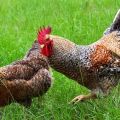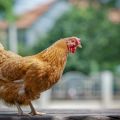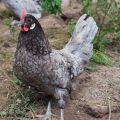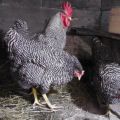Description and characteristics of the Maran chicken breed, the subtleties of the content
Chickens of the Maran breed are widespread not only in Russia, but also in Europe. They are grown for industrial purposes and on their own farms. These chickens have a special egg color - dark brown. People call them "Easter eggs". The breed has a variety of artificially bred colors.
Breeding history
The maran breed is feathered chickens. They were first presented at a French exhibition in 1914. 15 years later, a livestock community for breeding Maranov was organized. In 1934, the breed spread and got to an exhibition in England, where they called them Minors.
True, for the British, the presence of plumage on their paws was not suitable; individuals with clean paws were selected for breeding. After some time in England, they organized their own Maran club.
Later, the breed spread to America, where clubs were also created. The Americans argued with the British and yet adopted the French vision of the breed with feathers on the metatarsus. The founder of all colors of chickens was black and copper. On the basis of the Maran, the Americans bred a popular bird species called the Araucan Minorca.
It took a long time to develop other colors. The new bird colors at the exit did not meet the generally accepted Maran standards. However, over time, it turned out to breed chickens with a non-standard plumage color.
Description of the characteristics of chickens Maran
Characteristics of chickens include the appearance of the male and female, productivity, character in relation to other chickens.

Bird appearance
The ridge on the head is small, bright red, which touches the back of the head. The head itself is small, medium in size. Chickens have a powerful curved beak. The color of the face of the head is red, the eyes are small, orange-red.
Birds have a long neck, strong with a bend, covered with fluffy feathers that smoothly pass to the shoulders. The rooster is 1 kg larger than the female. Outwardly, the chicken does not look large, although it has a good weight.
The sternum is wide, with developed muscle mass. The bushy tail is small in size, the slope is 45 °, this is a distinctive feature of the breed.
The legs of the chicken are large, the metatarsus are pink, of medium size, gray or white claws at the ends. There are small feathers between the pluses.
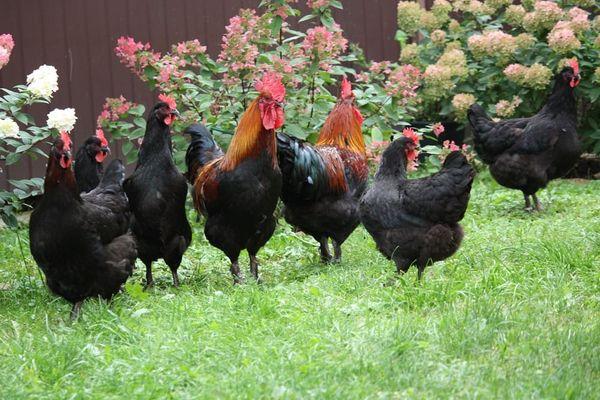
Important! The lower part of the metatarsus is always white, regardless of the color of the Maran.
Productivity
The breed has an average egg production. On average, hens lay about 140 eggs per year. This value may vary. This number of eggs is obtained by observing all the rules of bird care and keeping in favorable conditions. One egg weighs 65 g, in rare cases, chickens lay 100 g of eggs, inside which there are 2 yolks.
Maran meat has a pleasant taste due to its white color. Males have an average weight of about 4 kg and females 3.5 kg. This is a good indicator for raising chickens for meat.
Character
The birds are calm, pliable and non-conflicting. They easily go into the arms of the owner, take root with other breeds and species.
Advantages
Birds of the Maran breed have many advantages. These include:
- average egg production;
- large individuals, can be grown for meat;
- unpretentious care;
- the ability to keep in an open chicken coop and cages;
- special color of eggs;
- variety of colors.

disadvantages
This breed has practically no flaws. However, a few still note:
- the inability to get identical chicks when crossing;
- thick shells in eggs, which chicks cannot always break through when hatching;
- not very high egg production.
Varieties
Chickens Maran have a huge range of colors. The founder of almost all subspecies is the black-copper type.
White
White birds have snow-white feathers. This color is inherited by the recessive gene, therefore the presence of feathers or shades of a different color indicates that the chicken is not purebred. The hocks of the white Maran are pink, which is a distinctive feature of the subspecies.
Wheat
Males are similar to a black and copper breed. They have a black body and a brownish-red color on the head and back. However, the spread of the copper color is wider than that of the founders. Females have a more characteristic wheaten color. Their breasts are wheat, with a red border at the ends of the feathers. The rest of the body is light brown.
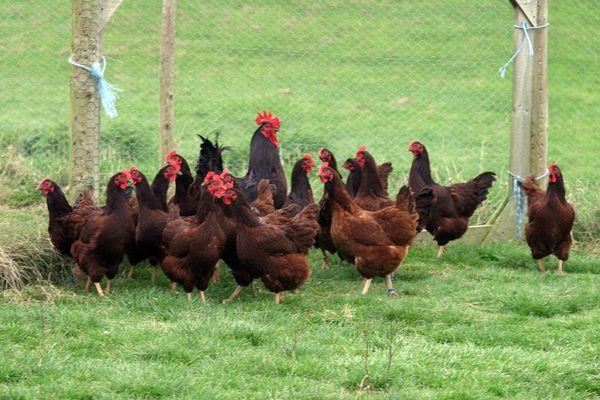
Black copper
Bicolor hens. In females, the copper color is more pronounced. The whole body is black, except for the neck and back. The brighter the copper color, the more purebred they are. All other parameters of chickens meet standards.
Silver cuckoo
Both the male and the female have a variegated black and white color. However, roosters are lighter than hens. There are a few brown feathers. The red comb looks pretty impressive. This type of maran can be crossed with black chickens. The offspring will show black cocks, and females of black and white speckled color.
Colombian color
The chicken is white in color with a small splash of black feathers in the neck. The plumage is wavy at the edges. The tail is fluffy, black. A feature of the Colombian type is the waviness of the plumage.
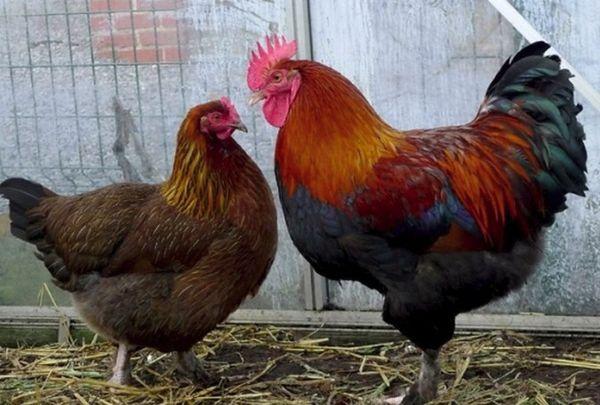
Lavender
This type of color has several variations. It may take on a reddish tint. The head of the roosters is snow-white, which smoothly turns into gray towards the bottom of the body. In the female, on the contrary, the head is gray, and the bottom of the body is almost white. The color transition is smooth and has no clear boundaries.
Salmon
Rooster of bright salmon color. The tail is dark brown, with red feathers on the back and wings. The lower legs are covered with brown plumage. Females are colored similarly, but have a less bright shade.
The black
Both sexes of the breed are completely black. The color can be emerald or slightly red. This type of chicken is rare, as it is difficult to obtain black Maranes that fully comply with generally accepted standards.
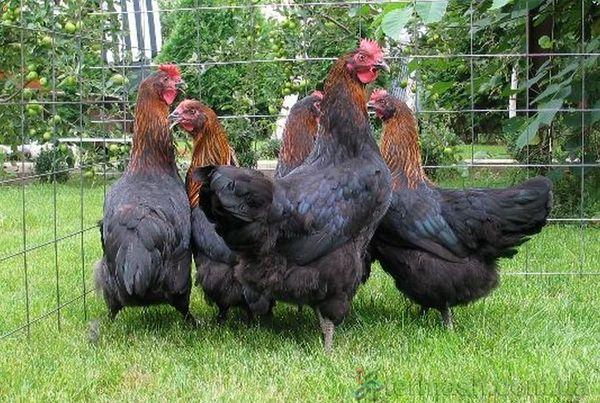
Blacktail
Males have a bright copper body and a black tail.Females are completely brown with dark brown tails. All other parameters are in accordance with standards.
Breed tips
To ensure the good development of birds, it is necessary to create favorable conditions for growing and keeping.
What should be the chicken coop?
The chicken coop should be insulated for the winter. Chickens can easily survive low temperatures up to 5 ° C. However, the establishment of heating in the room helps to maintain year-round egg production. It is also required to create conditions for the roost. Forms nests for layers. Allocate a place for drinkers and feeders.
Temperature, lighting, humidity
Chickens prefer a well-lit area, it is desirable to provide them with daily walking in the fresh air with full daylight hours. The optimum air temperature is 20-25 ° C, and the percentage of humidity is 70-80.
Important! High humidity contributes to the development of diseases in chickens.
Preparing the yard
The yard for the walk is surrounded by a fence so that the chickens cannot go far. Periodically, the place of walking is changed, so it is rational to use a portable fence.
There should be a canopy at the site of the yard so that the birds have a place to hide during bad weather.

Drinking bowls and feeders
Drinking bowls and feeders are installed inside the chicken coop or cage. It is important that the supply of liquid and feed is constant. Birds shouldn't starve. However, with intensive weight gain, it is recommended to put individuals on a protein diet.
Winter maintenance
Maranas endure winter in a heated barn. For this, they provide constant heating using infrared lamps, a built-in oven or an electric heater. With a sharp drop in temperature, a decline in egg production occurs.
How to feed the birds?
For chickens and adult chickens, the diet is slightly different.
Chicks
In the first 1.5 months, chicks feed separately from adult chickens. They are given:
- cottage cheese;
- eggs;
- millet;
- corn millet;
- nettles;
- alfalfa.
Chickens are provided with a protein type of nutrition, then adult foods are gradually introduced into the diet.

Adult chickens
Adult chickens are fed with compound feed purchased in stores or prepared independently. The composition includes:
- wheat grains;
- corn;
- meal;
- barley;
- peas;
- feed yeast;
- shredded shells;
- salt.
And also in the diet there are greens: nettles, alfalfa, cabbage leaves, clover, cut grass.
How to breed a breed?
For breeding chickens choose a young male and 5-6 females. Leave them alone to mate. The most brightly colored eggs are chosen for incubation.
Incubation
Incubation lasts 21 days. Each day has its own temperature regime. The dense shell ensures the safety of the chicks until they hatch. Also, such a tightness of the shell requires regular ventilation. Sometimes it is difficult for chicks to break through the shell, so they need help.
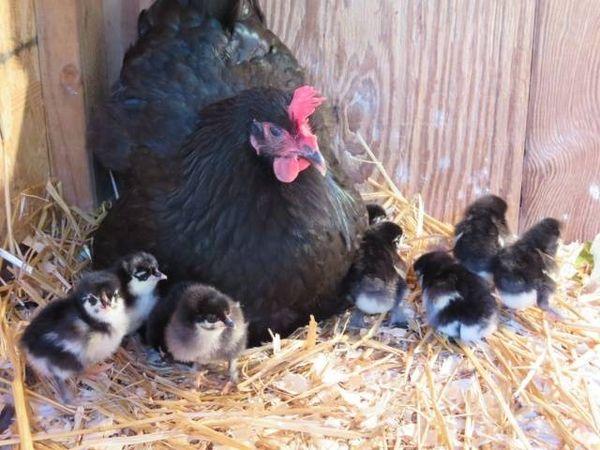
Growing young animals
The first 2-3 weeks of chicks are kept separately from adult birds. They are fed and given manganese water to prevent infection. From the age of one week, they gradually begin to be taken out into the street. By 30 days of age, they are transferred to a common chicken coop.
Diseases and methods of dealing with them
Under unfavorable conditions, birds are susceptible to infection. When the first signs appear, treatment is urgently needed.
Dropsy of the abdominal cavity
The causes of the disease are metabolic disorders in the body of the chicken. The internal organs of the bird suffer, it becomes lethargic, the abdomen tenses, the movement of the chicken becomes difficult. For treatment, they give diuretics and pierce the abdomen with a syringe in order to pump out the liquid.
Ascariasis, heterokidosis
With the manifestation of helminthiasis, antihelminthic drugs are mixed in the bird feed. And also carry out a complete disinfection of the premises and feeders.When affected by nematodes, the chicken becomes lethargic and does not gain weight well.
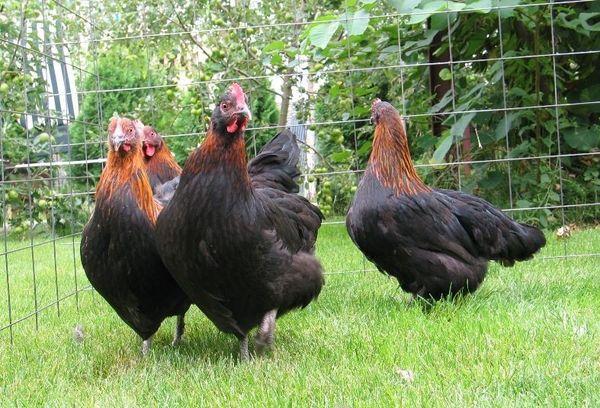
Scabies
The scabies mite enters the chicken paws, causing itching and discomfort. The disease is contagious, so you need to treat it as soon as possible. To do this, the paws of the bird are soaked for 15 minutes in soapy water.
Important! For an improved effect, it is recommended to process each individual.
Pooferoids
These are insects that feed on dead particles of the epithelium, and also penetrate the feathers. The place of localization of the parasite is the neck and cloaca. The affected feathers are removed and burned. A box with wood ash and sand is installed in the chicken coop.
Where to buy and at what price?
Maranov eggs and young chickens are purchased from industrial nurseries, and can also be ordered online. One hatching egg costs 100 Russian rubles. One-week-old chicks cost 200-250 rubles, and two-week-old chicks cost 300 rubles.
